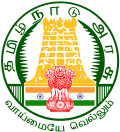Achievements
The Government introduced various schemes like Kudimaramaththu Work similar to Telangana's Mission Kakatiya, FAME India scheme and Amma Patrol in Tamil Nadu to ascertain the security of women and children in public places. In response to the introduction of mandatory NEET exams starting in 2017, Palaniswami government formed a high-level committee led by M. Anandakrishnan in May that year to reform the Tamil Nadu school education system. [3] The school textbook syllabus and exam pattern for classes 1 to 12 were revised on par with CBSE standards in phases, starting from the 2018–19 academic year, to better prepare students for competitive exams. [4] [5]
On 15 August 2018, Palaniswami Government announced a 2% sub-quota in select government jobs and State Public Sector Undertakings for national, state, and international-level medal-winning sportspersons in games organized by recognized federations, later increasing it to 3% on 16 October 2018. [6] [7]
In 2019, The Chief Minister went on a 13-day tour in the United States, United Kingdom and United Arab Emirates to promote foreign investment in Tamil Nadu. While there he launched the Yaadhum Oore programme (lit. all countries, based on Purananuru 192) to encourage the Tamil diaspora to re-invest in Tamil Nadu. [8] During trip he secured 3 lakh crores worth of foreign investment, a greater amount than even his predecessor Jayalalithaa did. His administration created new districts such as Tenkasi, Kallakurichi, Tirupattur, Ranipet and Chengalpattu in 2019, and Mayiladuthurai in 2020, by carving them out from existing districts. [9] After six decades of waiting by the people, Palaniswami laid the foundation stone for the ₹1,652-crore Athikadavu–Avinashi Groundwater Recharge and Drinking Water Supply Scheme on 28 February 2019, and the project work commenced on 25 December that year. [10] [11]
In February 2020, Palaniswami led Tamil Nadu government declared the Cauvery delta region as a Protected Special Agriculture Zone. The announcement was widely hailed by political parties and farmers organisations. [12] [13] [14]
In 2020, Palaniswami led AIADMK government passed order for 7.5% Quota in Medical Admissions for Govt. School Students. [15] He took action to set up government medical colleges in newly formed 11 districts which offered 1,650 more seats to then existing 3,400 seats. [16] [17] After the first three phases of excavation by the Archaeological Survey of India (ASI) at Keezhadi between 2014 and 2017, the Palaniswami Government, whose State Department of Archaeology took over further excavations in consultation with the ASI, initiated the fourth phase of excavations in 2017–18 with an allocation of Rs.55 lakh, during which as many as 5,820 rare artifacts and brick constructions dating back to the Sangam era were excavated. On 20 July 2020, Palaniswami laid the foundation for the Keezhadi museum to showcase the artefacts unearthed from Keezhadi excavation site in Sivagangai district. [18]
Under this governance, Tamil Nadu was rated as the best governed state based on a composite index in the context of sustainable development according to the Public Affairs Index-2020 released by the Public Affairs Centre in Oct. 2020. Palaniswami is also praised for his administration during the coronavirus pandemic. Tamil Nadu was one of the few states that did not register negative growth in the period of pandemic.
During this regime, Tamil Nadu was the best performing big state overall from the year 2018 to 2021. With a gross state domestic product of $290 billion or Rs 21.6 lakh crore, Tamil Nadu became India's second-largest economy. [19] [20] [21]
In 2020, the study “States of the State” of India Today, said that Palaniswami led Tamil Nadu has topped in 11 categories from a total of 12, including economy, tourism, infrastructure, inclusive development, law and order, along with entrepreneurship, cleanliness, environment, health, education and agriculture. Tamil Nadu had been chosen for this recognition for the third consecutive year. [21]

